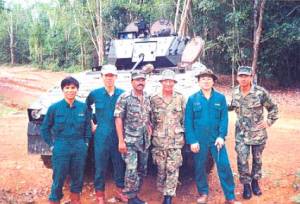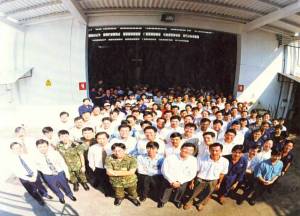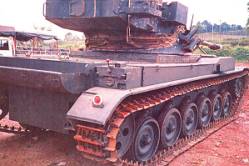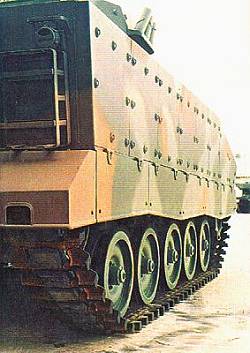 |
| Bionix History of Development - From the Beginning to 1992 | |
|
|
|
| Introduction : The works recorded in this book represent the culminated efforts of a group of daring and persevering people. They also serve as a living testimony of the accomplishments of these people in developing the first local Infantry Fighting Vehicles. This book would not have been made possible if an outstanding engineering team did not overcome all odds and persevere in their quest to build the first IFV. It would also not have been made possible if the group of dedicated scribes amongst them had not taken the steps to document the seven and half years of works. Hereby, we are proud to present you the very first documented record of the IFV developmental process. The success of this project weighed heavily on the synergy created from the tri-partite working relationship between HQ armor, Defense Material Organization and ST Automotive. The three agencies produced men and women who formed the engineering team which made possible what was once an imagination. We have chosen to describe to you first of all how the idea of an IFV was conceived. Next to come is the project infant stage, whereby the preliminary technology investigation was undertaken. What took place after that was a series of incredible developmental advances between 1990 to 1996. Today, the first two units of the First Article stand before you on this Commissioning Day. They are the first fruits of the IFV Family that have been produced. They stand upright in quiet confidence knowing you will trust in them and that not fail you in the days to come. |
|
|
How It All Began : Along with the growth and development of the Singapore Armed Forces (SAF), there was a need to top up the shortfall of the M113 Armored Personnel Carrier (APC) in the current inventory. This prompted the Ministry of Defence (MINDEF) to source for a fleet of armored vehicles to operate hand-in-hand with the current fleet of M113 and SM1. DMO being the systems acquisition house of the DTG, together with the participation of the SAF, was appointed to conduct a technology study and recommend the direction ahead of this project. A market survey was conducted in which various armored vehicles including WARRIOR, BRADLEY, MARDER were evaluated. The findings from the market survey showed that none of the off-the-shelf vehicles in the world met our unique requirement matrix. Therefore, the committee decided that local development would be the natural path. Local development was necessary because firstly, no vehicle in the market was able to satisfy our Army requirements adequately. Secondly, this would also serve as a good opportunity to build up the capability of the local defense industires. After a series of deliberation, the decision for local development was endorsed. |
|
|
Project Management Team : In the meanwhile, ST Automotive had been exploring with the idea of designing a vehicle suitable for local use. Their idea was consolidated and presented to MINDEF, which was assessed to be viable and suitable for further study. Moreover, they were deemed as a suitable candidate based on expertise and experience drawn from past maintenance and retrofitting works with MINDEF. The working committee was set up with DMO as the programme and Technology Manager, HQ Armor as the Operational Manager and STA as the Prime Contractor. This was not the first alliance between the three parties, they were previously involved in the upgrading programme of the AMX 13 - SM1 light tanks. Moreover, the three parties were also involved in an on-going programme to upgrade the existing fleet M113 APCs. With this close understanding and co-operation, the three parties embarked on the local development approach to design and build an IFV for the SAF. |
|
|
|
|

Some members of the DMO & HQ Armor project team |
 STA Team |
 Members of the Steering Committee |
 Part of the team that drove the IFVs |
|
Early Technology Investigation : Way back in 1988, even before the decision to develop the IFV was endorsed, DMO, G5 Army and HQ Armor had always been on a look out for development in IFV technology to meet the future need of the Army.  The
team took the initiative to conduct a technology investigation exercise to
assess the viability on introducing new vehicular technologies.
Subsequently, STA was roped into the investigation to gain first hand
experience as well as to provide fabrication and design support. This was
a follow up to the SM1 programme whereby the aims were to introduce new
technology into existing SM1 tanks and to create a learning platform for
the design and trial team to build up their knowledge and expertise to
meet the future demands. The
team took the initiative to conduct a technology investigation exercise to
assess the viability on introducing new vehicular technologies.
Subsequently, STA was roped into the investigation to gain first hand
experience as well as to provide fabrication and design support. This was
a follow up to the SM1 programme whereby the aims were to introduce new
technology into existing SM1 tanks and to create a learning platform for
the design and trial team to build up their knowledge and expertise to
meet the future demands.In this exercise, the trial team studied the impact of vehicle ground pressure and configuration on mobility, more effective turret/gun control systems and crew survivability. With the confidence gained through the hands-on investigation, the team moved ahead to introduce these and other new technologies in the IFV programme. |
|
 Programme In Its Infancy :
Programme In Its Infancy :The road to the full development and freezing of the final design started with the building of Experimental Vehicles, then the TestBeds, and eventually the Final Prototypes. In each phase, a contract was awarded separately to design, build and test the vehicles. In the meantime, DMO formed a project management team which consisted of members who were involved in the early technology investigation exercise. They were divided into various technology areas and tasked to introduce latest vehicular technology into the programme. New concepts and design methodology were formulated to integrate these technologies in the most expedient manner so as to achieve a cost effective solution for MINDEF. STA, on the other hand, assembled a design team to perform the detailed design and developmental work. The team consisted of designers who were part of the SM1 Upgrading Team who had ample armored vehicle design and testing experience. Moreover, there was an efficient and well-qualified fabrication support team dedicated to assist in the project. Upon the consolidation of these personnel and the inclusion of the Army's representative, the tri-partite project team was born. |
|
| Experimental Vehicles
(1990 - 92) In the experimental Phase, two experimental vehicles were made. The first experimental vehicle, XV1, was conceptualized in August 1989 and rolled out in Jan 1990 while the second vehicle, XV2 was based on a new design. They were used to test the new running gear and power pack systems as well to firm up the IFV specifications. |
|
|
|
|
|
|
|
| Introduction 1 - 2 - 3 - 4 - 5 | Bionix Specifications | Bionix Gallery 1 - 2 - 3 - 4 - 5 | Bionix 40/50 Gallery |
| ARV Spec and Gallery | AVLB Spec and Gallery | Primus Spec and Gallery | Other variants |
| IFV -others 1 - 2 - 3 - 4 | 1990 - 1992 | 1993 - 1995 | 1995 - 1997 |
| Are you arrive at this page through a link from another site or search
engine ? Click here to go to one35th main index page. Created by 0ne35th Last update on Tuesday, 20 September 2005 |
|||
All photos are
either legally obtained
from exhibitions, product brochures, magazines, manufacturers or by personal collection.
Copyright © by one35th Homepage, All rights reserved